How to analyze and process the privacy data of multiple users in the cloud environment without leaking personal privacy is an urgent problem to be solved. Multi-key fully homomorphic encryption (MKFHE) supports computations on encrypted data under different public keys (users), and the result ciphertext can be jointly decrypted by all involved users, which can be used to realize secure data process and privacy protection between different users in cloud environment. During the process of joint decryption, current MKFHE schemes usually need relevant techniques in secure multi-party computing (MPC), such as oblivious transfer (OT) protocol, to ensure the security of the ciphertexts broadcast process, thus making the decryption process complicated. Beyond that, the final decryption result is not controllable, which is not suitable for the scenario that we need the specified legitimate users to get the final result. In order to solve this problem, this paper designs a directional decryption protocol based on MKFHE,and protocol’s security is based on LWE (learning with errors) problem, which can be reduced to the worst-case hardness of problems on ideal lattices. Comparing to the decrypting process in MKFHE scheme MW16, the directional decryption protocol in this paper allows any legitimate user to perform the final decryption process, thus enhance the controllability of decryption result for the data owner. Moreover, the relevant techniques of MPC are not needed in our protocol, which reduces the complexity of the decryption process, and is promising for future applications.

